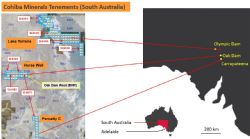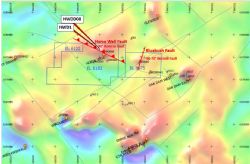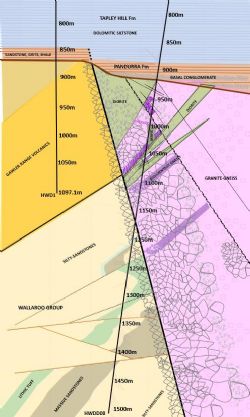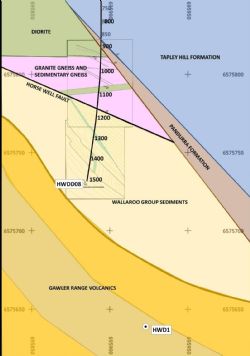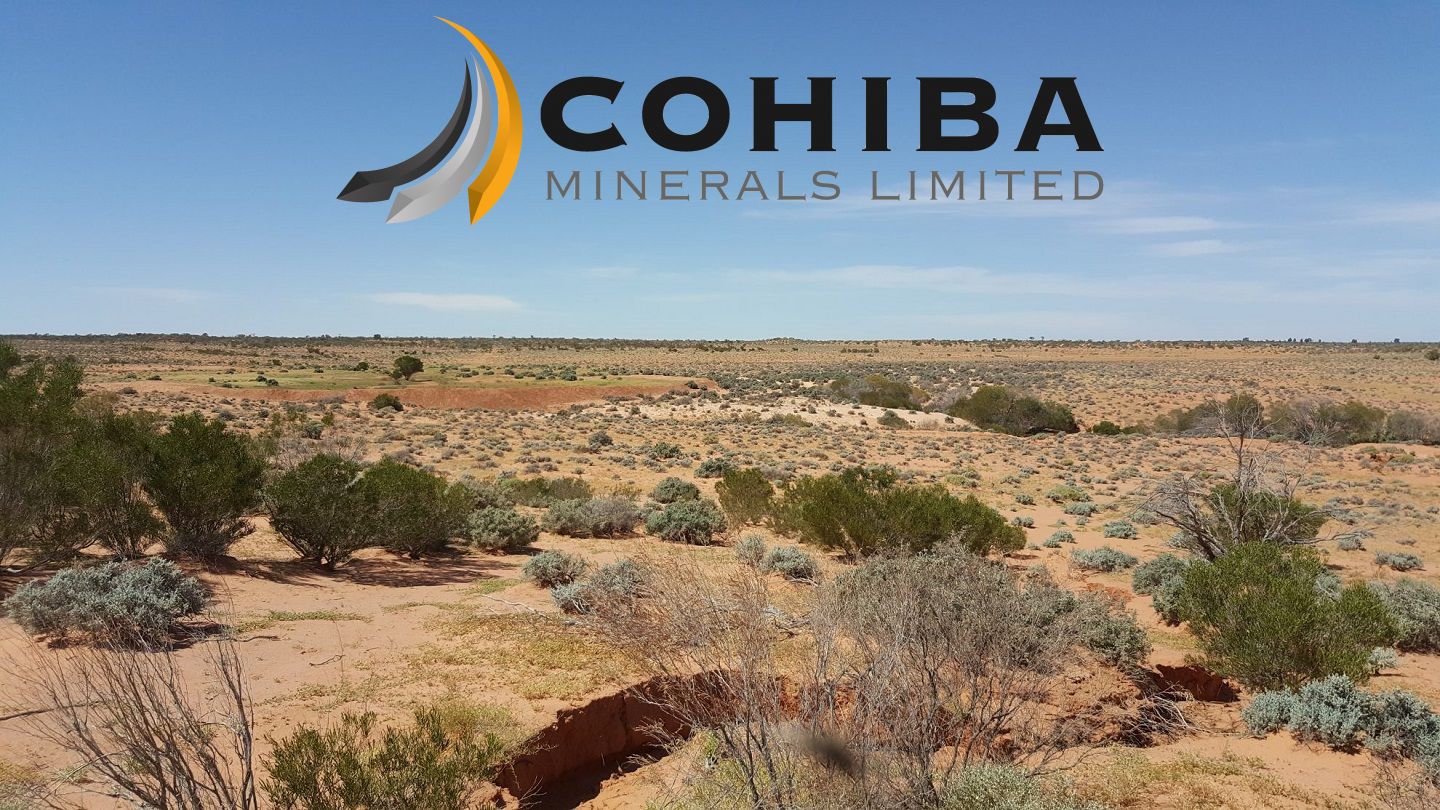 Drilling at Horse Well Continues to Point to IOCG Potential
Drilling at Horse Well Continues to Point to IOCG Potential
Melbourne, Dec 22, 2022 AEST (ABN Newswire) - Cohiba Minerals Limited ( ASX:CHK) (
ASX:CHK) ( CHKMF:OTCMKTS) is pleased to provide an update to the market in relation to the drilling at the Horse Well Prospect (Figure 1*).
CHKMF:OTCMKTS) is pleased to provide an update to the market in relation to the drilling at the Horse Well Prospect (Figure 1*).
Highlights:
- Horse Well drill hole HWDD08 followed-up Western Mining's greenfields exploration hole (HWD1) and has significantly expanded the copper anomaly and confirmed the Horse Well Fault as a highvalue target.
- The Horse Well Fault is interpreted to have caused the brecciation and been formed at the same time as copper mineralization, making it a prime target for further IOCG (Iron Ore Copper Gold) exploration.
- HWDD08 intersected the newly discovered major Horse Well Fault with an offset of over 600m.
- HWDD08 encountered copper mineralisation (chalcopyrite) and varying degrees of brecciation in all basement rock units and the base of cover.
- HWDD08 encountered strong copper mineralisation (bornite) at the base of the paleo-weathering zone.
- Cohiba Minerals is eagerly awaiting assay results from the lab which are expected early in the March 2023 quarter.
HWDD08 was completed to 1509.9m on 12 October 2022 with the drill rig subsequently stranded on site until 25 November 2022 due to significant rainfall. The hole was designed to follow up on low level but persistent copper mineralisation encountered in Gawler Range Volcanics (GRV) in the historic WMC (Western Mining Corporation) hole, HWD1, drilled in June 1982.
Importantly, HWDD08 fulfills many of the preconditions Cohiba is looking for in an IOCG target:
- Structural preparation and the creation of porosity with pervasive brecciation.
- Fluid pathway from deep mantle derived fluids to surface through a major structure.
- Evidence of reduced deep fluid input with magnetite-chalcopyrite-pyrite mineralization.
- Evidence of two fluid mixing with oxidized magnetite-hematite-chalcopyrite-pyrite veins.
- Strength of mineralization with disseminated chalcopyrite-pyrite.
Cohiba's CEO, Andrew Graham says, "The Horse Well Prospect continues to provide significant encouragement that we are exploring in exactly the right locations. With persistent low-level copper mineralisation, the presence of beneficial structural controls and evidence of desired fluid chemistry and mixing we are convinced that the Horse Well Prospect is a major IOCG target zone. We remain committed to investigating it to the fullest extent possible and applying the best technical rigour to maximise the likelihood of exploration success."
HWDD08 encountered the newly described 'Horse Well Fault', an ENE-WSW striking Reverse Fault dipping steeply to the NNE. Stratigraphic offset over this fault is a minimum of 600m, making this a large fault feature.
The basement geology in the hanging wall of the fault consists of granite-gneiss, sedimentary gneiss, diorite, and a mafic dyke, which is consistent with the geology seen in other holes on the tenement.
In the foot wall of the fault, HWDD08 encountered a thick package of Wallaroo Group finely bedded sandstones and some volcanic tuff. The interpretation is that the Gawler Range Volcanics encountered in HWD1 lie stratigraphically above the Wallaroo Group sediments (Figure 8*).
Pervasive copper mineralisation of varying intensity was encountered through most of the basement rock units, including the base of the cover sequence in the Pandurra basal conglomerate. The deformation properties of the rock units strongly affected mineralisation intensity, with the granite-gneiss deforming brittlely and having the strongest mineralisation, conversely the Wallaroo Group tending the deform at a large scale and having the least mineralisation. A particularly strong bornite zone was encountered from 937-945m at the base of paleo-weathering. Copper in chalcopyrite was the dominant mineralisation in HWDD08 and was associated with chlorite/magnetite/chalcopyrite/pyrite breccia infill and veins; magnetite/magnetite-hematite/hematite-chalcopyrite/pyrite veins and breccia infill; disseminated chalcopyrite/pyrite; and siderite/chalcopyrite/pyrite stringers.
Some degree of breccia development occurs throughout HWDD08, from irregular microfaults to crackle breccia, clast supported breccia and minor milled breccias, with crackle brecciation being the most common. Brecciation appears to relate to the Horse Well Fault.
The Horse Well Fault and associated breccias are considered to have formed during the timeline of regional IOCG (Iron Ore Copper Gold) deposit formation. This interpretation is based on the breccia textures that mirror those seen in and around other IOCG deposits, and the copper mineralisation is exploiting the porosity created by this brecciation event, indicating that brecciation and mineralisation occurred at the same time.
Follow-up work may include drilling a wedge hole off HWDD08 in order to test for a 'near-miss' and to increase confidence in the orientation of the Horse Well Fault, as a fault cannot be orientated from one drill hole with a high degree of accuracy. Additional broad-spaced drilling may be required. A review of the geophysics will be used to prioritize targets. Additionally, HWDD08 does not explain the 100m jump in the basement contact, with further sub-parallel faults predicted.
*To view tables and figures, please visit:
https://abnnewswire.net/lnk/85U13R95
About Altair Minerals Limited
 Altair Minerals Limited (ASX:ALR) (OTCMKTS:CHKMF) is listed on the Australian Securities Exchange (ASX) with the primary focus of investing in the resource sector through direct tenement acquisition, joint ventures, farm in arrangements and new project generation. The Company has projects located in South Australia, Western Australia and Queensland with a key focus on its Olympic Domain tenements located in South Australia.
Altair Minerals Limited (ASX:ALR) (OTCMKTS:CHKMF) is listed on the Australian Securities Exchange (ASX) with the primary focus of investing in the resource sector through direct tenement acquisition, joint ventures, farm in arrangements and new project generation. The Company has projects located in South Australia, Western Australia and Queensland with a key focus on its Olympic Domain tenements located in South Australia.
![abnnewswire.com]()
Related Companies
Social Media
Share this Article

 ASX:CHK) (
ASX:CHK) ( CHKMF:OTCMKTS) is pleased to provide an update to the market in relation to the drilling at the Horse Well Prospect (Figure 1*).
CHKMF:OTCMKTS) is pleased to provide an update to the market in relation to the drilling at the Horse Well Prospect (Figure 1*).  Altair Minerals Limited (ASX:ALR) (OTCMKTS:CHKMF) is listed on the Australian Securities Exchange (ASX) with the primary focus of investing in the resource sector through direct tenement acquisition, joint ventures, farm in arrangements and new project generation. The Company has projects located in South Australia, Western Australia and Queensland with a key focus on its Olympic Domain tenements located in South Australia.
Altair Minerals Limited (ASX:ALR) (OTCMKTS:CHKMF) is listed on the Australian Securities Exchange (ASX) with the primary focus of investing in the resource sector through direct tenement acquisition, joint ventures, farm in arrangements and new project generation. The Company has projects located in South Australia, Western Australia and Queensland with a key focus on its Olympic Domain tenements located in South Australia. 


